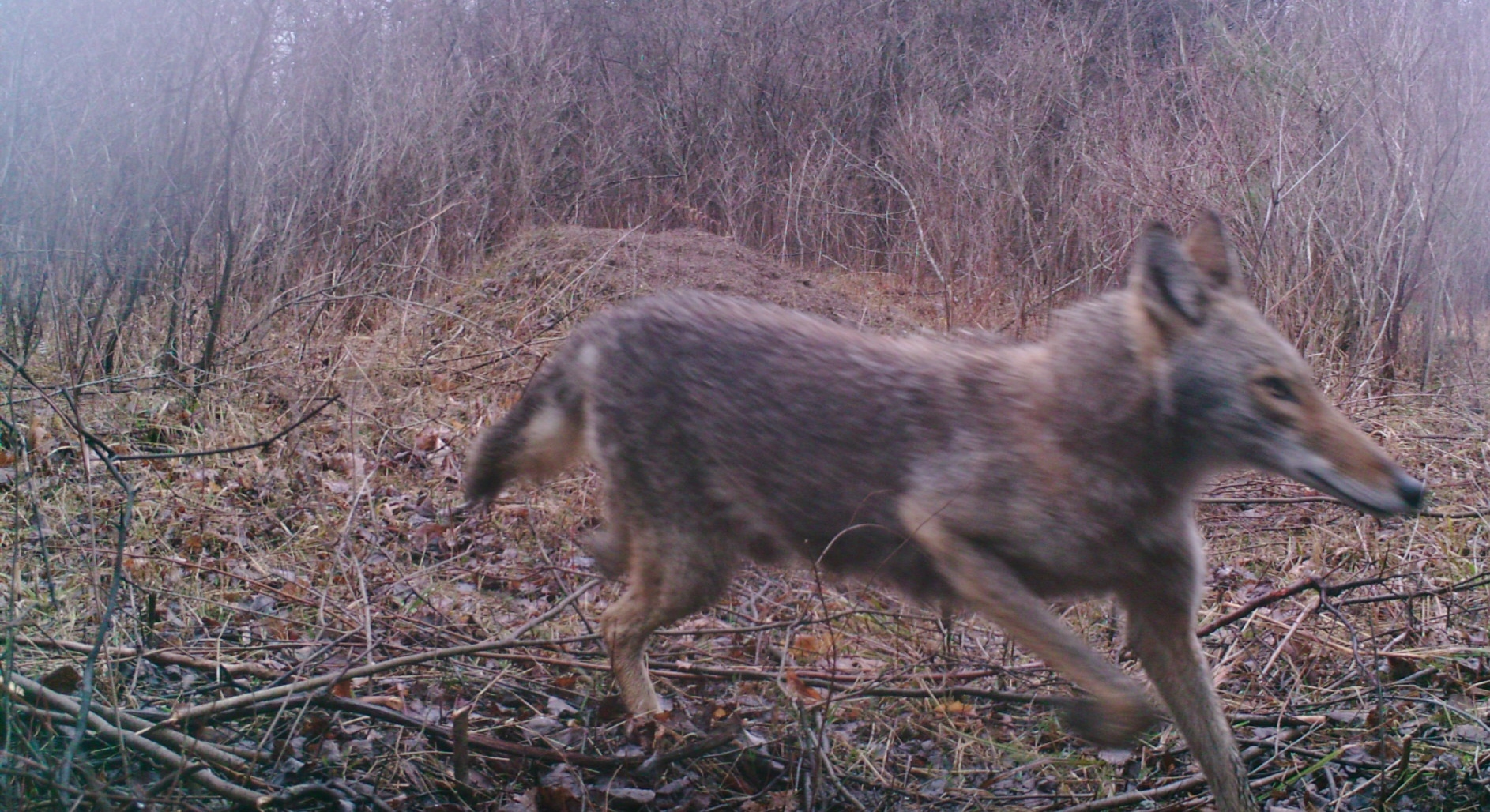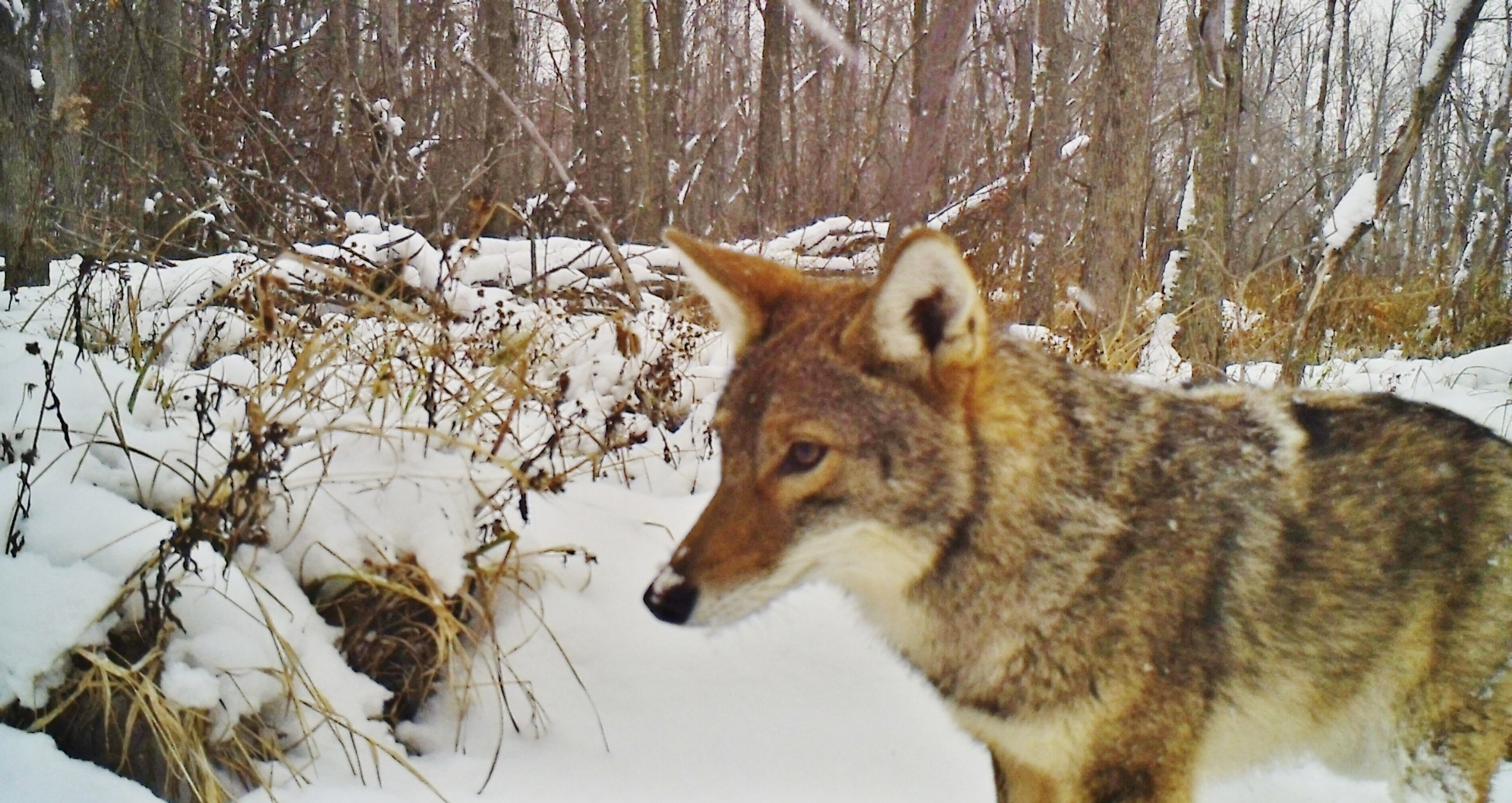WILDER SIDE OF OAKLAND COUNTY
The eastern coyote (Canis latrans) is an intelligent, curious, and highly adaptable animal. Although once confined to the great American deserts and prairies where they were targets of ceaseless eradication campaigns, coyotes have now colonized our nation from coast to coast. “Unlike wolves, which succumbed quickly to predator control measures, decades of intensive persecution did not eradicate coyotes – the unrelenting pressure on them did invoke an ancient coyote biological imperative: It triggered larger litters of pups and colonization behavior that pushed them into new settings everywhere.” – Dan Flores in his 2016 book Coyote America.

Today coyotes inhabit forests, mountain ranges, river valleys, coastal wetlands, grasslands, meadows, enormous wildlands, and public parks. Coyotes are no longer a phantom of the urban landscape. They have adapted to life in big cities including Chicago, New York, San Francisco, and Detroit. Every county in Michigan has coyotes. They are found from coast to coast and are a part of the American landscape. Coyotes are incredibly opportunist and accept whatever nature or humans provide in the way of habitat and food. The entrée list is long and includes meadow voles, rats, rabbits, roadkill, snakes, frogs, fish, fruits, fawns, insects, and pet food. They are also putting a dent in golf course loving Canada Goose populations and will readily take eggs and flightless goslings.

Oakland County is Coyote Country. Coyotes are learning and adapting to our ways far faster than we even try to learn their ways, however living together in peace is practical and possible. There is no reason to be frightened by a simple sighting of a coyote. Unfortunately, print and television media sometimes respond to increasingly common sightings with sensational fear-inducing news stories using phrases such as “The coyote was seen lurking in the woods.” Coyotes do not “lurk” in the woods any more than a deer or squirrel “lurks” in the woods. For the past few weeks sightings have increased in Oakland County as they do this time of the year. It’s usually only a fleeting glimpse, or an image captured by a motion-activated camera trap.

Normal coyote behavior includes being active day and night, hunting in fields for meadow voles, dashing across trails and roads, playing in fields, and yipping and howling during the night. They could be sitting in plain view, relaxing on a hilly vantage point, watching human activity from a distance and sometimes watching dog walkers as they wander. Coyotes, just like dogs and humans, are curious and very aware of their world. We are part of their world.

There are ways to keep coyotes wild and away from you. If a coyote is encountered in the neighborhood or your yard, it’s important to never turn and run away. The message given to the coyote tells it, “I am top dog – the human is afraid.” Keep moving forward and yell at the coyote. It will leave. The one exception is at a coyote den. Don’t approach. Don’t bother the coyote. It may very well stand its ground just as domestic dog would stand its ground to protect its pup.
Feeding coyotes intentionally or unintentionally is dangerous for they will associate the human presence with a food source. A well-stocked bird feeder with spillage will attract small mammals, which in turn may attract coyotes. Ignoring the presence of a coyote will encourage the coyote. If there are no negative consequences for staying close to humans and homes, there is no reason to leave. That was the unusual case last summer of coyote pups that took to playing and napping on one homeowner’s porch in a suburban neighborhood in Oakland County near a wooded area. She ignored their presence and watched from inside.
If that homeowner had banged pots and pans or loudly yelled “Go away Coyotes!” or just pounded on the window they would have left. Being “Big, Bad, and Loud” sends a clear message to the coyote: “Go away, stay away.” Keeping coyotes wild and wary is the key to coexistence. Killing a coyote does not make a community healthier or safer. Another coyote will fill the vacuum. It’s wiser, and a very easy process to “train” a coyote. It’s called hazing. It keeps coyotes wild and wary and is the right thing to do.

Hazing, or aversive conditioning, is the process of disturbing a coyote’s sense of security to such an extent that it decides to stay away. Hazing is a powerful tool for the homeowner to use to reinforce a coyote’s natural wariness of people. Yelling at a coyote, blowing a whistle, jumping up and down, or waving a broom about will quickly drive a coyote away from the yard. Popping an umbrella open and bluff charging the coyote will make it flee. A small air horn held in the hand and blasted, accompanied by human yelling is also good hazing. Hazing must be repeated, it’s not a one-time thing. Throwing objects while yelling at a coyote may send it on its way, or it may not. Objects not to be thrown include hot dogs, eggs, steak, mangoes – you get the point. Be creative, but be sensible. Throwing food will bring the coyote back.

Photo credit: Project Coyote
California-based Project Coyote is an excellent science-based organization that promotes coexistence between people and wildlife through science, education, & advocacy. The hazing field guide from Project Coyote is also excellent for use here in Oakland County. Visit their website for excellent information on coyotes, coexistence, and hazing.

Some agencies suggest homeowners create a “coyote shaker” if a coyote tends to loiter on their property. Coyote shakers are easy to make and embolden children and encourage them to be active participants in hazing a coyote. All you need are about a dozen pennies, some aluminum foil and an empty pop can. Here’s how to make and use a coyote shaker, courtesy of Stanley Park Ecological Society in Vancouver.

Spring is almost here and the trails of our county beckon. It’s time to head out and explore the wilder side of Oakland County, and practice coexistence with North America’s Song Dog, the eastern coyote.
ADDITIONAL RESOURCES
- https://urbancoyoteresearch.com/
- http://www.michigan.gov/dnr
- https://www.wildlife.ca.gov/Keep-Me-Wild/Coyote
Jonathan Schechter is the Nature Education Writer for Oakland County Government and blogs weekly about nature’s way, trails, and wildlife on the Wilder Side of Oakland County.
For the latest county news and events, visit our website and follow along with us using #OaklandCounty on our Facebook, Twitter, Instagram, and LinkedIn pages.






Thanks for writing an article that both gave practical advice and which refused to encourage the coyote “paranoia”, as I’ve been calling it, that I keep seeing all over social media. As someone who grew up in Lake Orion, I’m well aware how possible it is to co-exist in the same area as coyotes. They’re not new and they’re certainly not bad. You’ve got great tips and explanations in here that I hope people will read and try.
There were two coyotes in our backyard this afternoon, snooping around the chicken coop (near South Blvd. and Adams Rd.)… while foxes are regular visitors to the yard, this is the first for coyotes.
[…] hidden salamanders, numerous species of birds, eastern massasauga rattlesnakes, mink, deer, fox, coyotes, ferns and an impressive array of wet woodland […]
[…] the know about their behavioral pattern, it can be rather comical. But some birds of prey, and the eastern coyote, will simply call the bluff and snag a meaty meal, for an adult hognose is a hefty snake and can be […]
[…] is abundant. The list of some of the more notable and recognizable species includes eastern coyote, red fox, gray fox, northern water snake, eastern massasauga rattlesnake, Blanding’s turtle, […]
[…] willow drew my attention when I noted tracks in the mud at its base that were created by a coyote. I paddled on wondering if the creator of the tracks might just be on the other side of the massive […]
[…] northern water snakes to hunt frogs and fish. Muddy tracks on the boardwalk hinted that perhaps a coyote had used the curved boardwalk as a hunting platform for small creatures. As I wandered away from […]
[…] along the route pausing for other live mount nocturnal creatures including a Great Horned Owl, an eastern coyote, and a gray fox placed up on a tree branch. The gray fox location was a superb teaching point as […]
[…] of wildlife. Negative comments about opossums, raccoons, deer, wild turkeys and the much maligned Eastern Coyote seem to spread like wildfire as Thanksgiving draws near. Some neighborhood social media sites fuel […]
[…] their flight is to reach tree tops and nightly roosting spots free from predators, especially the eastern coyote: a connoisseur of turkey, not just on Thanksgiving, but any day of the […]
[…] species of wildlife look at opossums as a delicacy, including red-tailed hawks, great horned owls, coyotes, and red fox. In human inhabited areas, opossums often meet their demise in the teeth of dogs and […]
[…] of native Michigan wildlife that included a black bear, gray fox and a wealth of information on coexisting with deer and coyotes, as well as special display for the upcoming maple festival. I relaxed by the […]
[…] County, for the landscape is always changing. In the mudflats of the Rouge River I found very fresh coyote tracks, a reminder that nature always finds a way when given half a chance, even when surrounded by […]
[…] a long list of local lurking predators including Barred Owls, Great Horned Owls, Red-tailed Hawks, coyotes, red fox, gray fox, weasels, mink, feral and domestic cats, and dogs. Baby rabbits in their nests […]
[…] frogs, bullfrogs, northern water snakes, garter snakes, skunks, hawks, gulls, raccoons, foxes, coyotes, mink, otters, turtles, and humans that savor the flavor of frog […]
Rochester Hills residents need to know that trapping or hunting coyotes is against the city law. There are a number of extermination companies in the area advertising that they will trap coyotes for you. This is against the law and they will be fined.
Well this morning (10/13/18) at 7:20 am, we let the dogs out to the back yard. within minutes, I saw my little white dog (7.5 lbs) in the jaw of a coyote. I ran out chasing them when the coyote was running away with my dog in his mouth. I kept running and screaming and finally it dropped my dog. Luckily my dog was alive and was not hurt. If it’s found 2 seconds later, my dog would have been gone. 😰
We live in North Wixom, by Proud Lake.